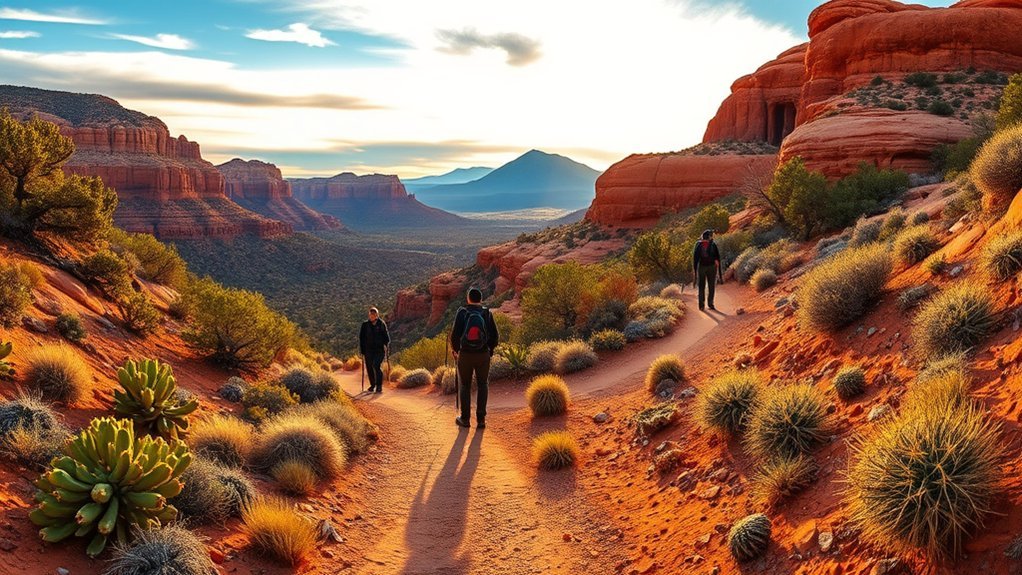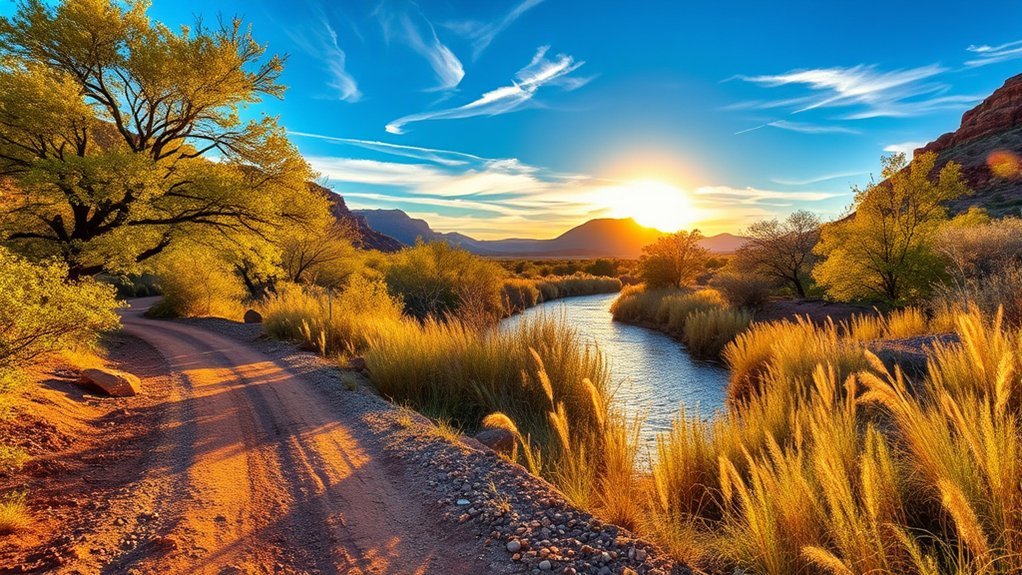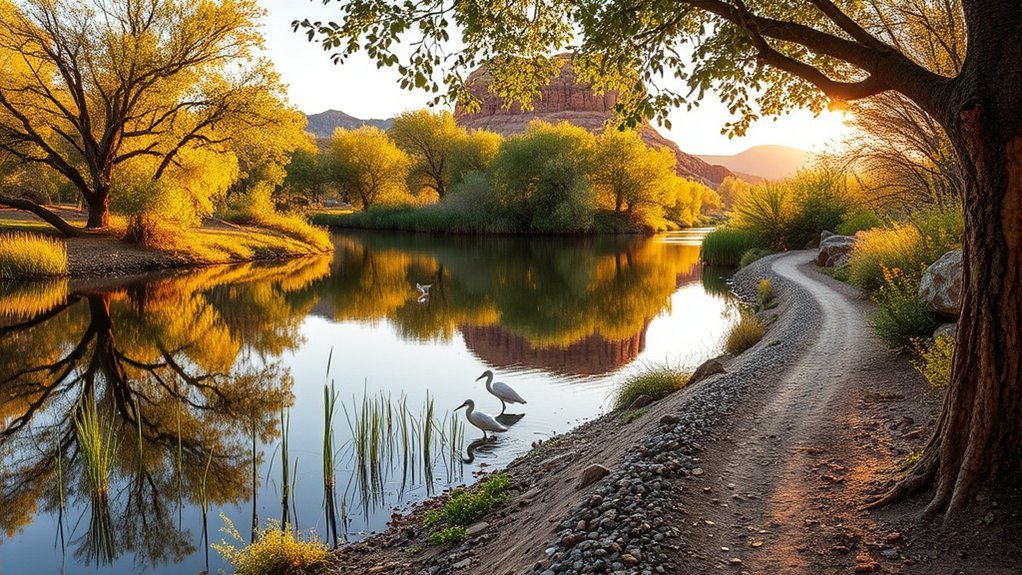You’ll find surprisingly varied terrain within a short drive of Cottonwood, from riparian strolls along the Verde River to steep, rocky ridgelines with wide valley views. You can pick an easy family loop or plan a tougher half-day push up Mingus or Black Canyon—each trail has specific hazards and highlights to know before you go. Keep going to match trails to your fitness, gear, and season.
Top Cottonwood Trails to Start With

Whether you’ve got an hour or a full day, Cottonwood’s trail network serves up accessible, scenic options for every skill level. You’ll find gentle loops at Dead Horse Ranch State that suit quick outings and wildlife spotting: the Dead Horse Ranch Lagoon Loop is an easy 1.7‑mile accessible circuit (0.5–1 hr) ideal for bird- and fish‑watching, while the Verde River to Lagoon Loop runs 2.7 miles, offers river access and lagoons, and welcomes dogs—expect well‑maintained but sometimes dusty footing. For a shaded, sandy stroll, take the 1.7‑mile Jail Trail River Walk from North Main Street to Dead Horse Ranch; it’s flat, good for hummingbird sightings, and has easy parking. If you want more challenge, step up to longer routes: North Mingus Loop (4.1 miles, moderate with steep rocky spots) gives sweeping Verde Valley views, and Black Canyon Trail (about 7.4 miles) tests you with rugged desert terrain and saguaros.
Dead Horse Ranch State Park Loops

When you stroll into Dead Horse Ranch State Park, you’ll find a cluster of short, accessible lagoon loops that make wildlife viewing easy and rewarding—West (0.39 mi), Middle (0.41 mi) and East (0.72 mi) offer quick circuits, while the popular Dead Horse Ranch Lagoon Loop (1.7 mi, about 30–60 minutes) circles three scenic lagoons rich with birds and fish. You can pick a loop for a quick nature break or combine routes for a longer outing; all are mostly flat, sandy or dusty, and well marked. Bring water, wear sturdy shoes for some loose dirt, and expect occasional bugs near the water. Parking at main trailheads is generally good, and early mornings are best for bird activity and cooler temps. These lagoon loop options are ideal if you want easy, rewarding wildlife viewing without committing to the park’s longer singletrack or connector routes used by cyclists and riders.
Verde River to Lagoon and Riparian Walks

If the lagoon loops whetted your appetite for water and birds, head farther along the riparian corridor where the Verde River to Lagoon Loop and nearby riverside paths offer longer, shady stretches and easy river access. You’ll find the Verde River to Lagoon Loop (2.7 mi, easy) a well‑maintained, dog‑friendly stroll through Dead Horse Ranch State Park with frequent beaver sightings and abundant birdlife. Combine that with the Dead Horse Ranch Lagoon Loop (1.7 mi) to circle three quiet ponds—West, Middle and East—for excellent fish and waterfowl viewing on mostly flat, accessible trails. The Jail Trail River Walk (1.7 mi) gives a shaded, sandy riverside route from North Main Street into the park, notable for hummingbirds. Trail surfaces vary from sandy and dusty to packed dirt with occasional loose sections; parking’s easy and a short ADA canopy loop sits at the River Day Use Area. Start early for cooler light, fewer people, and the best wildlife activity—observers note beavers, plentiful birds, and occasional bear tracks.
Black Canyon Trail and Desert Challenges
Though demanding, the Black Canyon Trail rewards you with rugged Sonoran desert scenery—saguaro forests, sweeping canyon views and boulder-strewn stretches—over roughly 7.4 miles of technical trail. You’ll face a long, strenuous outing: plan on 4–4.5 hours and expect the route to be about 1.5 miles longer than some maps indicate. Locals advise descending via Trail 106 and climbing out on Trail 105 to follow the known route and avoid the mapped “missing” section.
Trail conditions get technical with exposed boulder fields, loose rock and steep sections that require careful footwork. Shade is limited, so carry extra water, electrolyte snacks and wear sturdy footwear with good traction. Watch for variable footing and typical Sonoran wildlife; take breaks to enjoy expansive desert vistas and saguaro stands. Start early to beat heat, tell someone your plan, and consider trekking poles for stability. With preparation, the Black Canyon Trail delivers a rewarding, gritty desert adventure.
North Mingus and Mountain Loop Hikes
When you tackle North Mingus and the Yeager Canyon loops you’ll face mixed rocky terrain with a few very steep, technical sections that reward careful footing and sturdy shoes. The North Mingus Loop clocks about 4.1 miles (2.5–3 hours) with some very steep spots and excellent views across Lonesome Valley and the Bradshaws, while longer variations push elevation gain toward 2,300 feet. Bring plenty of water and expect expansive valley and mountain vistas from switchbacks through pinyon‑juniper and ponderosa pine.
Trail Difficulty & Terrain
Because the North Mingus Loop and the Mountain Loop cover rocky, often steep ground, you should expect moderate-to-challenging footing for much of each hike. The North Mingus Loop is rated Moderate, about 4.1 miles with steep, rocky sections and a couple very steep technical spots that demand careful footing and slow, deliberate steps. It gains substantial elevation and usually takes 2.5–3 hours. The Mountain Loop links Yeager Canyon and North Mingus with switchbacks through pinyon-juniper and ponderosa pine, exposing ridgelines and rocky tread underfoot. Expect uneven terrain, occasional boulder scrambling, and limited shade on exposed stretches. Bring sturdy footwear and trekking poles, carry extra water in summer, and trust your navigation on signed loops while staying cautious on steep ascents and descents.
Scenic Views & Highlights
After you’ve sized up the footing and gear needs on the North Mingus and Mountain Loop hikes, turn your attention to the views those climbs reward you with: both routes lift you into pinyon‑juniper and ponderosa stands that open onto wide panoramas of the Verde Valley, Lonesome and Prescott Valleys, and distant ranges like the Bradshaws. On the North Mingus Loop you’ll earn excellent panoramic views after negotiating a few steep, rocky pitches; bring layers for exposed ridgelines. Yeager Canyon and other mountain‑loop routes use switchbacks to deliver repeated viewpoints over Lonesome and Prescott Valleys. Short options like the Mesa Trail give quick scenic views near Red‑Tail Hawk campground, while longer climbs such as Bear Mountain offer dramatic cliff‑top outlooks — best with sturdy footwear and water.
Yeager Canyon and Scenic Viewpoint Routes
Though the Yeager Canyon Loop skirts the western flank of Mingus Mountain, you’ll feel immersed in pinyon‑juniper and ponderosa pine as the trail threads steep switchbacks that open onto sweeping views of Lonesome Valley, Prescott Valley, and the Bradshaw Mountains. You’ll follow packed dirt and rocky singletrack that climbs into higher‑elevation forest; expect steep sections and variable footing, so wear shoes with reliable traction. The full loop takes about 2–3+ hours depending on pace and how long you linger at overlooks. Plan visits for golden hour—Yeager Canyon’s viewpoints deliver beautiful views and broad valley panoramas that are excellent for photography and generally less crowded than nearby Sedona spots. Access comes from Mingus Mountain road trailheads; parking exists but fills quickly on weekends and in summer, so arrive early. Carry water, layers for changing elevation, and a basic first‑aid kit. Move deliberately on switchbacks and rocky stretches to keep the hike enjoyable and safe.
Short Family-Friendly and Accessible Trails
You’ll often find these short trails around Cottonwood are perfect for families and visitors with mobility needs — they offer easy, well‑marked routes, shaded rest spots, and close‑up views of lagoons, riparian trees, and wildlife without the strain of longer hikes. Start at Dead Horse Ranch State Park: the Lagoon Loop is an accessible trail of 1.7 miles (30–60 min) that circles three lagoons teeming with birds and fish. For even shorter options, try the Middle and East Lagoons loops (0.41 mi and 0.72 mi), both stroller‑ and wheelchair‑friendly for quick wildlife viewing. In the River Day Use Area, the Canopy ADA Loop is a 0.25‑mile shaded accessible trail under Fremont cottonwoods — ideal for toddlers and mobility‑impaired visitors. The Verde River to Lagoon Loop stretches 2.7 miles along the river with good parking and frequent beaver sightings, best in early morning. Nearby Forest and River Loops (~0.5 mi each) offer picnic spots, gentle terrain, and simple navigation for small children.
Sedona Red Rock Day Trips From Cottonwood
You can reach Sedona’s red rocks from Cottonwood in about 20–30 minutes via 89A, making quick day trips to iconic formations like Cathedral Rock and Bell Rock very practical. Try short, high-reward hikes such as Doe Mountain, Kisva Trail at Red Rock State Park, or Secret Slickrock for sunrise or sunset shots. Remember many trailheads require a Red Rock Pass and parking fills up fast, so start early and plan where you’ll park.
Quick Sedona Access
From Cottonwood, a quick 20–30 minute drive up Route 89A puts you at Sedona’s famous red‑rock trailheads, so you can get a full day of iconic hikes without an overnight stay. You can plan Sedona day use easily: arrive early to secure parking and a Red Rock Pass during peak season. Choose short, family‑friendly options like Kisva Trail or Oak Creek Trail for creekside shade and picnics, or aim for panoramic half‑day routes such as Baldwin Loop or Robbers Roost for photography. If you want a tougher outing, tackle Bear Mountain or Templeton Trail for big elevation and creek access. Monitor Cathedral Rock’s lot—it fills fast—so leave Cottonwood at dawn for the best access.
Top Short Red-Rock Hikes
Set out from Cottonwood for half‑day Sedona trips that deliver big red‑rock scenery without a long commitment: these short hikes—Kisva, Baldwin Loop, Cockscomb, Doe Mountain, and Cathedral Rock—range from easy creekside strolls to steeper scrambles, so you can pick based on time, fitness, and shade needs. In the Cottonwood area, Kisva Trail at Red Rock State Park is a flat, shady 1.3‑mile out‑and‑back (62 ft gain) that follows Oak Creek—ideal for picnics, birdwatching, and families. Baldwin Loop (3.3 miles, 105 ft gain) offers classic Cathedral Rock views; bring a Red Rock Pass. Cockscomb (1.5 miles, ≈330 ft) is best late afternoon. Doe Mountain (1.46 miles, ≈446 ft) gives compact panoramas via switchbacks. Cathedral Rock is steeper (1.7 miles, ≈925 ft) with short scrambles and top rewards.
Historic and Cultural Trails: Tuzigoot & Montezuma Castle
While exploring the Verde Valley’s archaeological heart, you’ll find two complementary sites—Tuzigoot National Monument’s hilltop pueblo and Montezuma Castle’s riverside cliff dwelling—that together illuminate Sinagua life with accessible trails, interpretive exhibits, and visitor centers. You can walk the Tuzigoot Trail, a 0.5-mile, 55-foot-gain self-guided loop around a 110-room pueblo with interpretive signs and a visitor center showcasing artifacts. Montezuma Castle offers a short, accessible interpretive walk to view a well-preserved five-story, 50-room cliff dwelling and onsite exhibits explaining construction and excavation.
| Feature | What to expect |
|---|---|
| Setting | Tuzigoot: panoramic hilltop views; Montezuma Castle: riverside, close-up cliff view |
| Trail length | Tuzigoot Trail: 0.5 miles loop; Montezuma Castle: very short accessible walk |
| Interpretation | Tuzigoot visitor center artifacts; Montezuma Castle educational exhibits |
Both sites prioritize preserving Sinagua sites and give clear historical context, so you’ll leave with a solid sense of pre-Columbian life in the Verde Valley.
Trail Safety, Timing, and Wildlife Tips
Start early—around 6:00 AM on popular routes—to beat the heat, pollen, and crowds and to give yourself extra daylight for longer connectors. Carry plenty of water for multi‑use loops, wear sturdy shoes (and poles if needed), and bring a map or GPS because some sections are sandy, loose, or intermittently signed. Watch for wildlife signs—birds, beavers, occasional snakes, and even bear tracks—and give animals space while following shared‑use etiquette.
Start Early, Stay Hydrated
Because Cottonwood’s low-elevation trails heat up fast, plan to hit the trail before 8:00 AM so you avoid midday sun, see calmer wildlife, and reduce heat-related risks. You’ll have easy access to cooler hours on routes like Dead Horse Ranch Lagoon Loop and Verde River to Lagoon Loop. Carry at least 1 liter of water per hour, pack extras for longer routes, and bring electrolyte replacement for hot days. Wear sun protection and breathable layers; desert tracks like Black Canyon Trail offer little shade, riparian sections give brief relief. Bring a map or GPS, tell someone your route, and expect snakes, lizards, and occasional bear tracks—give wildlife space and don’t startle them.
| Tip | Why it matters |
|---|---|
| Early start | Cooler temps, calmer wildlife |
| Hydration | Prevents heat illness |
| Navigation | Avoid getting lost |
Watch for Wildlife Signs
Often you’ll spot signs of wildlife before you see the animals themselves—fresh tracks, scat, chewed vegetation, or sudden bird chatter can tell you what’s nearby and how active it is. Start early on the Verde River Lagoon Loop (by 6:00 AM) for beaver activity, birds, and occasional bear tracks. At Horse Ranch State Park, Middle and East lagoons host hummingbirds, waterfowl, and riparian species.
- Make noise on blind corners in brushy or rocky areas (Black Canyon Trail, Mingus foothills) to avoid startling mammals.
- Watch sandy, dusty surfaces for snakes and small critters; stay alert on lagoon loops.
- On multiuse trails yield to horses and bikes, leash dogs, and give wildlife space.
Pack Navigation and Safety
While you’re planning hikes around Cottonwood, prioritize navigation and basic safety so trips stay fun and uneventful: aim to hit trails like the Verde River to Lagoon Loop by 6:00 AM in summer to beat heat and crowds, carry at least 1 liter of water per hour of moderate exertion, and bring a map or GPS with route cues (Black Canyon is about 1.5 miles longer than some maps indicate—take Trail 106 down and 105 up). Wear sturdy shoes and use trekking poles on steep, rocky sections to cut slips and joint strain. Pack a headlamp, first-aid kit, sun protection, extra water and a charged phone or locator. Store food securely, watch for wildlife signs, and plan parking area and exit points for limited trailhead spaces.
Frequently Asked Questions
What Is the Most Scenic Hike in Arizona?
Cathedral Rock is widely considered Arizona’s most scenic hike; you’ll climb steep sandstone fins for dramatic red‑rock spires and panoramic Oak Creek Canyon views, so bring sturdy shoes, water, and a camera for unforgettable vistas and photo ops.
What Is Special About Cottonwood, AZ?
Cottonwood’s special because you get easy access to red‑rock vistas, Oak Creek Canyon, and Dead Horse Ranch’s riparian trails, plus Old Town tasting rooms, historic charm, and nearby varied hikes—ideal for outdoor adventure and food-and-wine breaks.
What Are the Big 3 Hikes?
You’ll find three standout hikes: Dead Horse Ranch Lagoon Loop, Verde River to Lagoon Loop, and Black Canyon Trail. You’ll enjoy easy lagoon strolls and serene river views, plus a rugged, challenging Sonoran Desert trek.
What Is the Most Beautiful Hike in Sedona?
Cathedral Rock is the most beautiful hike in Sedona; you’ll scramble 1.7 miles with steep sandstone climbs, gain about 925 feet, and be rewarded with iconic red‑rock fins and sweeping panoramic views over Oak Creek Canyon.
Conclusion
You’ve got options for every mood and fitness level, from easy lagoon loops perfect for birdwatching to rugged 7.4-mile Black Canyon climbs—so plan hikes that match your experience, start early, carry water, and wear sturdy shoes. Interesting fact: Verde River supports over 300 bird species regionally, making Cottonwood hikes great for wildlife viewing and photography. Use trail maps, respect seasonal closures, and leave no trace to keep these routes thriving for everyone.

